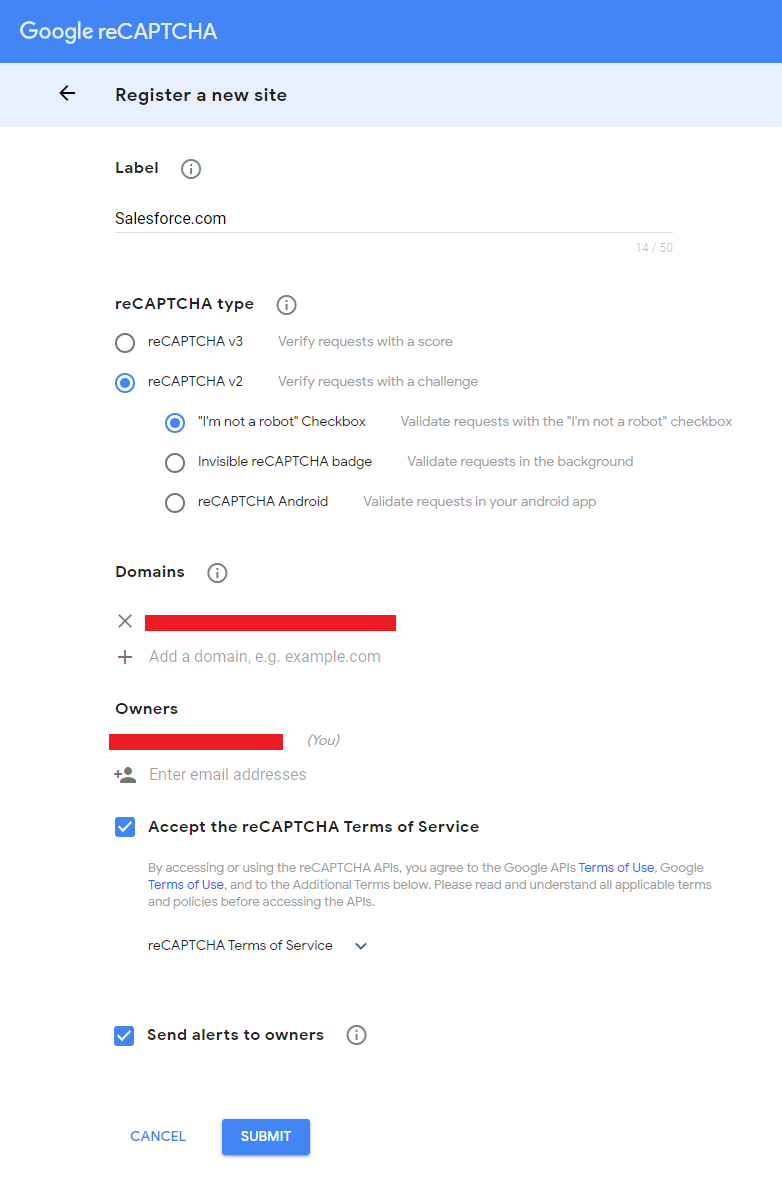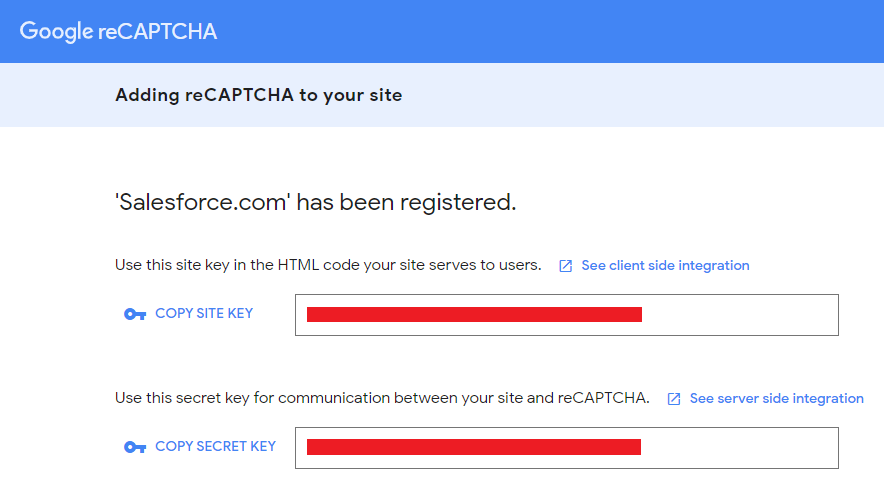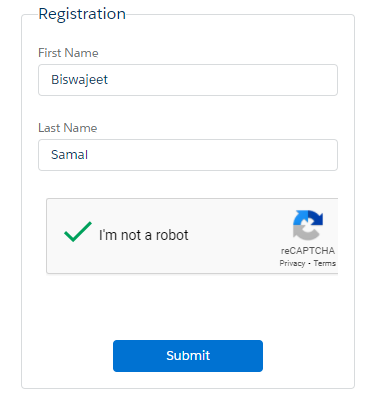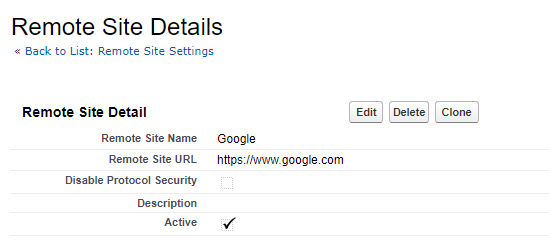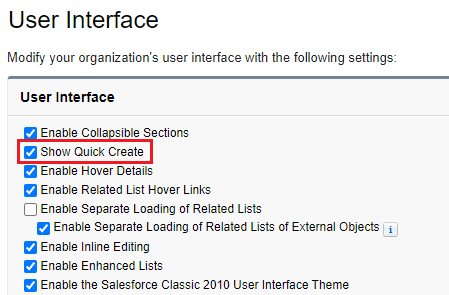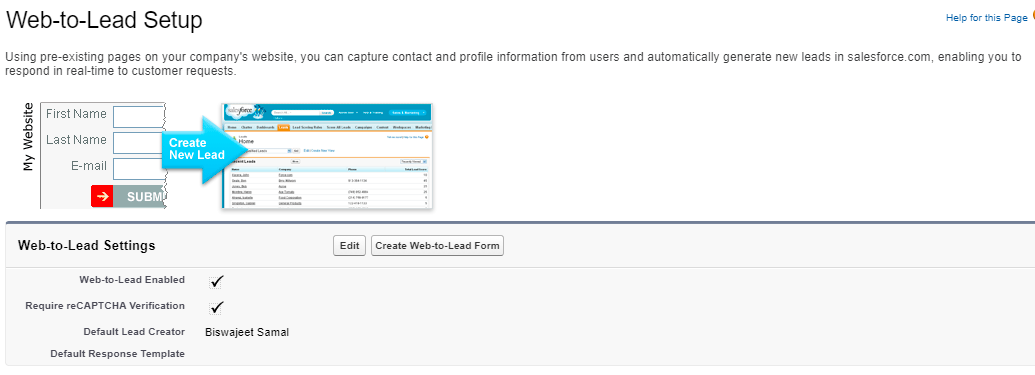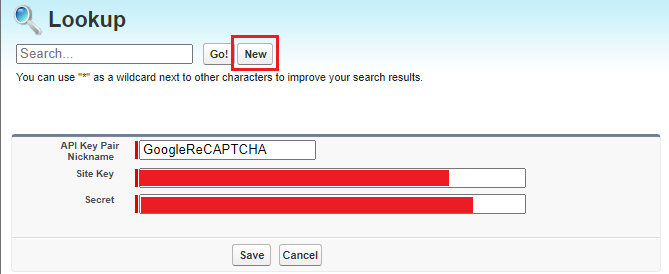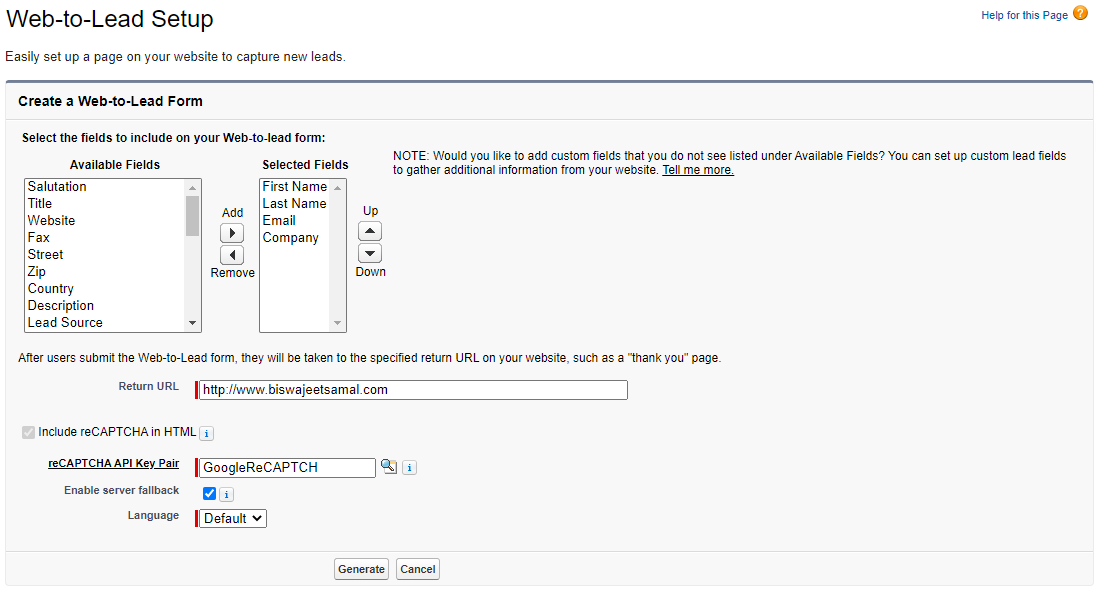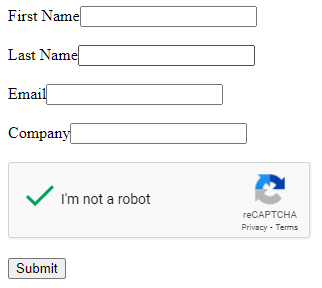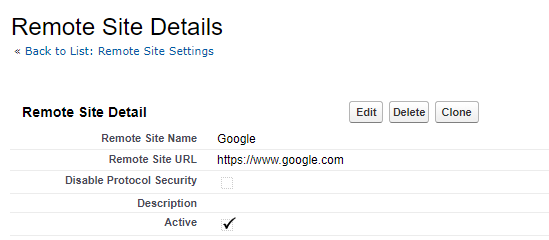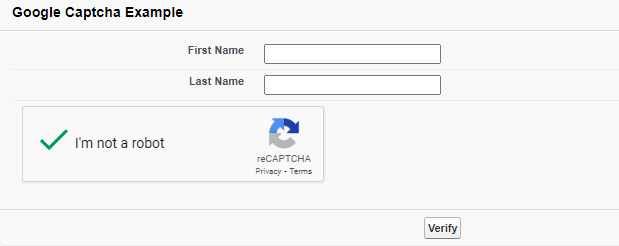Configure the Google reCAPTCHA and get the Site Key & Secret Key:
Login to Google reCAPTCHA
Register a new site
Add Label e.g. Salesforce.com
Select reCAPTCHA type “reCAPTCHA v2”
Select “I’m not a robot” Checkbox option.
Add a domain e.g. yourorgurl.com
Accept the reCAPTCHA Terms of Service
Submit and get the Site Key & Secret Key
Create a VF page to configure Google reCAPTCHA in it and we have to embed the VF page in our lightning component.
GoogleReCaptcha VF Page:
<apex:page sidebar="false" showHeader="false" standardStylesheets="false" cache="false" id="pg" applyBodyTag="false" applyHtmlTag="false">
<html>
<head>
<script src='https://www.google.com/recaptcha/api.js?onload=onloadCallback&render=explicit' async='' defer=''/>
<script type='text/javascript'>
var verifyCallback = function(response){
parent.postMessage('VALID', 'https://biswajeet-dev-ed.lightning.force.com/');
};
var onloadCallback = function() {
grecaptcha.render('reCAPTCHAWidget', {
'sitekey' : 'ADD_YOUR_GOOGLE_RECAPTCHA_SITE_KEY',
'callback' : verifyCallback
});
};
</script>
</head>
<body>
<div id="reCAPTCHAWidget"></div>
</body>
</html>
</apex:page>
Embed the above created VF page in our lightning component to display Google reCAPTCHA.Lightning Component:
<aura:component implements="flexipage:availableForAllPageTypes,force:appHostable,forceCommunity:availableForAllPageTypes" access="global">
<!--Attributes-->
<aura:attribute name="isDisable" type="Boolean" default="true"/>
<aura:attribute name="firstName" type="String"/>
<aura:attribute name="lastName" type="String"/>
<!--Handlers-->
<aura:handler name="init" value="{!this}" action="{!c.doInit}"/>
<div class="slds-m-around--xxx-large slds-align_absolute-center" style="width:70%;">
<fieldset class="slds-box slds-align_absolute-center" >
<legend id="newform" class="slds-text-heading--small login-heading">
Registration
</legend>
<lightning:input name="fName" label="First Name" value="{!v.firstName}"/>
<br/>
<lightning:input name="lName" label="Last Name" value="{!v.lastName}"/>
<br/>
<iframe src="/apex/GoogleReCaptcha" scrolling="no" frameborder="0" width="100%" allowtransparency="true"></iframe>
<div class="slds-align_absolute-center">
<lightning:button onclick="{!c.handleSubmit}" disabled="{!v.isDisable}" variant="brand" name="btnSubmit" label="Submit" />
</div>
</fieldset>
</div>
</aura:component>
Lightning JS Controller:
({
doInit : function(component, event, helper) {
var vfURL = 'https://biswajeet-dev-ed.lightning.force.com/';
window.addEventListener('message', function(event){
if(event.origin !== vfURL){
return;
}
if(event.data === 'VALID'){
component.set('v.isDisable', false);
}
}, false);
},
handleSubmit : function(component, event, helper) {
},
})
Loading...
Configure the Google reCAPTCHA and get the Site Key & Secret Key:
Login to Google reCAPTCHA
Register a new site
Add Label e.g. Salesforce.com
Select reCAPTCHA type “reCAPTCHA v2”
Select “I’m not a robot” Checkbox option.
Add a domain e.g. yourorgurl.com
Accept the reCAPTCHA Terms of Service
Submit and get the Site Key & Secret Key
Remote Site Settings:
Note: Make sure your org “Show Quick Create” is enabled.
Setup Web-to-Lead:
1. Go to Setup | Leads | Web-to-lead | Select the checkbox of “Web-to-Lead Enabled” | Select the checkbox of “Require reCAPTCHA Verification” | Select Default Lead Creator | Click on Save button at the bottom.
2. Click on “Create Web-to-Lead Form” button | Select Lead fields you want to add on the form | Give the redirect URL | Click the lookup icon to select “reCAPTCHA API Key Pair”.
3. In the popup window, Click on the New Button | Enter the “API Key Pair Nickname” of your choice | Enter Google reCAPTCHA Site Key | Enter Google reCAPTCHA Secret Key | Click on Save.
4. Click on Generate button, and you will get the HTML code ready to put on your website.
Web-to-Lead Form:
Loading...
Step 1: Configure the Google reCAPTCHA and get the Site Key & Secret Key
Login to Google reCAPTCHA
Register a new site
Add Label e.g. Salesforce.com
Select reCAPTCHA type “reCAPTCHA v2”
Select “I’m not a robot” Checkbox option.
Add a domain e.g. yourorgurl.com
Accept the reCAPTCHA Terms of Service
Submit and get the Site Key & Secret Key
Step 2: Add Google as a Remote Site in Salesforce
Step 3: Create apex controller
/*
@Author : Biswajeet Samal
@CreatedDate : 30th JUL 2020
@Description : Google ReCAPTCHA Controller
*/
public class GoogleReCAPTCHAController {
public Boolean verified { get; private set; }
public String response {
get {
return ApexPages.currentPage().getParameters().get('g-recaptcha-response');
}
}
public String firstName{get;set;}
public String lastName{get;set;}
public String publicKey {get;set;}
private String remoteHost{
get {
String ret = '127.0.0.1';
//Also could use x-original-remote-host
Map<String, String> hdrs = ApexPages.currentPage().getHeaders();
if (hdrs.get('x-original-remote-addr')!= null)
ret = hdrs.get('x-original-remote-addr');
else if (hdrs.get('X-Salesforce-SIP')!= null)
ret = hdrs.get('X-Salesforce-SIP');
return ret;
}
}
//Google Secret Key
private static String secretKey = 'ADD YOUR GOOGLE RECAPTCHA SECRET KEY';
private static String baseUrl = 'https://www.google.com/recaptcha/api/siteverify';
//Constructor
public GoogleReCAPTCHAController(){
this.publicKey = 'ADD YOUR GOOGLE RECAPATCHA SITE KEY OR PUBLIC KEY';//Google Site Key or Public Key
this.verified = false;
}
public PageReference submit(){
if (response == null ){
//Google recaptcha empty response
return null;
}
HttpResponse res = getGoogleReCAPTCHAResponse(baseUrl,'secret=' + secretKey + '&remoteip=' + remoteHost + '&response=' + response);
if (res != null ) {
JSONParser parser = JSON.createParser(res.getBody());
while (parser.nextToken() != null) {
if ((parser.getCurrentToken() == JSONToken.FIELD_NAME) && (parser.getText() == 'success')) {
parser.nextToken();
this.verified = parser.getBooleanValue();
break;
}
}
}
if(this.verified){
//Add your logic
return null;
}
else{
//Stay on page to re-try reCAPTCHA
return null;
}
}
//Get Google reCAPTCHA Service Response
private static HttpResponse getGoogleReCAPTCHAResponse(string requestURL, string body){
HttpResponse response = null;
HttpRequest req = new HttpRequest();
req.setEndpoint(requestURL);
req.setMethod('POST');
req.setBody (body);
try{
Http http = new Http();
response = http.send(req);
System.debug('ReCAPTCHA Response-' + response);
System.debug('ReCAPTCHA Body-' + response.getBody());
}
catch(System.Exception ex){
System.debug('ERROR Message-' + ex.getMessage());
}
return response;
}
}
Step 4: Create VF Page
<apex:page controller="GoogleReCAPTCHAController" sidebar="false" showHeader="false" cache="false" id="pg">
<script type='text/javascript' src='https://www.google.com/recaptcha/api.js'/>
<script type='text/javascript'>
function recaptchaCallback() {
var btnVerify = document.getElementById("pg:fm:pb:pbb:btnVerify");
if (btnVerify.classList.contains("hideButton") ) {
btnVerify.classList.remove("hideButton");
}
}
</script>
<style type="text/CSS">
.hideButton{
display:none !important;
}
</style>
<apex:form id="fm">
<apex:pageBlock title="Google Captcha Example" id="pb">
<apex:pageBlockSection columns="1" id="pbs">
<apex:pageBlockSectionItem >
<apex:outputLabel for="fnField" value="First Name"/>
<apex:inputText value="{!firstName}" id="fnField"/>
</apex:pageBlockSectionItem>
<apex:pageBlockSectionItem >
<apex:outputLabel for="lnField" value="Last Name"/>
<apex:inputText value="{!lastName}" id="lnField"/>
</apex:pageBlockSectionItem>
<apex:pageBlockSectionItem >
<div data-type="image" class="g-recaptcha" data-sitekey="{!publicKey}" data-callback="recaptchaCallback"></div>
</apex:pageBlockSectionItem>
<apex:pageBlockSectionItem rendered="{!verified}">
<p>Google reCAPTCHA verified successfully.</p>
</apex:pageBlockSectionItem>
</apex:pageBlockSection>
<apex:pageBlockButtons id="pbb" location="bottom">
<apex:commandButton action="{!submit}" styleClass="hideButton" value="Verify" id="btnVerify"/>
</apex:pageBlockButtons>
</apex:pageBlock>
</apex:form>
</apex:page>
Loading...
